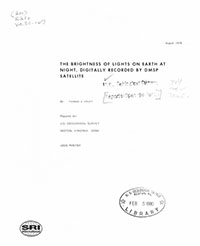The brightness of lights on Earth at night, digitally recorded by DMSP satellite
Links
- Document: Report (pdf)
- Download citation as: RIS | Dublin Core
Abstract
The U.S. Air Force has operated its Defense Meteorological Satellite Program (DMSP) for nearly a decade, and film images from the system have been openly available since 1973. Films are well suited for the study of weather, and users of such films have derived much useful data. For many potential remote sensing applications, however, a quantitative measurement of the brightness of the imaged light patterns is needed, and it cannot be extracted with adequte accuracy from the films. Such information is contained in the telemetry from the spacecraft and is retained on digital tapes, which store the images for a few days while they await filming. For practical reasons, it has not heretofore been feasible for the Air Force to provide a remote-sensing user with these digital data, and the quantitative brightness information has been lost with the erasure of tapes for re-use.
For the purpose of evaluation of tapes as a means for remote sensing, the Air Force recently did provide to the author six examples containing records of nighttime DMSP imagery similar to that which has previously 1 been evaluated by SRI International in a film format. The digital data create many new applications for these images, owing to a combination of several factors, the most important of which are the preservation of photometric information and of full spatial resolution. In this evaluation, stress has been placed upon determination of the broad potential value of the data rather than the full exploitation of any one aspect of it. The effort was guided by an objective to develop handling methods for the vast body of numbers--methods which will be practical for use in a research or engineering environment where budgets are limited, and specialized capabilities and image reproduction equipment has not already been developed. We report the degree of success obtained in this effort, pointing out the relative strengths and the relative limitations, as compared to the sophisticated, weather-oriented data processing which is well suited for the Air Force requirements.
Both geometric and photometric calibration methods are evaluated. An image can be considered as a 3-dimensional array, X, Y, Z, in which X and Y are the coordinates of a picture element (pixel) and Z is the brightness at that location. A method of approach to handling these parameters, particularly Y and Z, is developed in a form quite different from that which serves the operational applications.
The user of digital data will need the film images which are generated by the Air Force from the same data as is provided on digital tape. In the first stages of analysis, the films provide both a convenient index and a guide to identification of large patterns in the data. Additionally, the infrared (8 to 13 0 film provides a valuable indicator of cloud cover.
Two general conclusions are drawn from this study. Firstly, the digital DMSP data have great potential value but their cost, in terms of the interruption of the present operational routine, is quite high. Therefore, if a program is undertaken to provide for the open availability of an archive of digital records, great care must be exercised in selecting only those records which have unusually high value in order that the effort will be cost-effective. Secondly, it is concluded that several aspects of the program, well designed for Air Force operational purposes, are not adapted to earth-sensing needs. This is probably inevitable, since the two applications are largely different and in some ways incompatible. For example, the nighttime visual sensor saturates in the center of major cities and in moderately large fires (such as gas flares). This saturation prevents the analyst from integrating photometric parameters. For weather observation, this inability is unimportant, and acceptance of such saturation makes feasible a decrease in the data rate.
Such limitations in the data will probably be overcome only through modifying the existing system or the implementation of a similar system designed specifically to serve earth-sensing needs.
| Publication type | Report |
|---|---|
| Publication Subtype | USGS Numbered Series |
| Title | The brightness of lights on Earth at night, digitally recorded by DMSP satellite |
| Series title | Open-File Report |
| Series number | 80-167 |
| DOI | 10.3133/ofr80167 |
| Year Published | 1979 |
| Language | English |
| Publisher | U.S. Geological Survey |
| Publisher location | Reston, VA |
| Description | vi, 57 p. |


